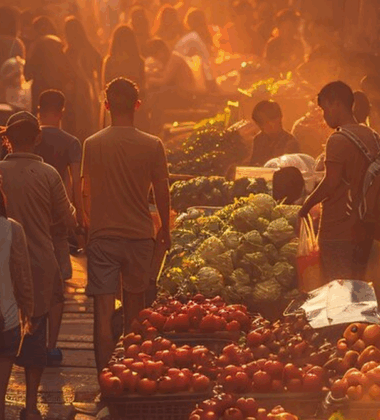Imagine a world where your dinner is designed by artificial intelligence, your snacks are 3D-printed, and your kitchen appliances know your dietary needs better than you do. This isn’t science fiction—it’s the future of food, and it’s happening right now.
The food industry is undergoing a seismic shift, driven by cutting-edge technology that’s transforming how we produce, prepare, and consume food. From AI-driven recipes to lab-grown meats, the possibilities are endless. For industry professionals, staying ahead of these innovations isn’t just an option—it’s a necessity.
In this educational deep dive, we’ll explore how technology is reshaping the food landscape and what it means for the future of your business.
1. AI in Food: The Chef of the Future
Artificial intelligence is revolutionizing the culinary world:
- Personalized Nutrition: AI analyzes your health data to create customized meal plans tailored to your unique needs.
- Recipe Development: Algorithms generate innovative recipes by combining flavors, textures, and ingredients in ways humans might never imagine.
- Supply Chain Optimization: AI predicts demand, reduces waste, and ensures fresher ingredients by optimizing the food supply chain.
Pro Tip: Embrace AI tools to streamline operations, enhance customer experiences, and stay competitive in a rapidly evolving market.
2. 3D-Printed Foods: The Next Frontier
3D printing isn’t just for plastics and metals—it’s making waves in the food industry:
- Customizable Meals: Create intricate designs and personalized portions for restaurants, hospitals, and even home kitchens.
- Sustainable Solutions: Use alternative ingredients like algae or insect protein to print eco-friendly foods.
- Space Exploration: NASA is exploring 3D-printed foods for astronauts, paving the way for futuristic dining experiences.
3. Lab-Grown Meats: A Greener Alternative
Lab-grown meats are set to disrupt the traditional meat industry:
- Ethical Eating: Produce meat without harming animals, addressing ethical concerns.
- Environmental Benefits: Reduce greenhouse gas emissions, land use, and water consumption compared to conventional farming.
- Market Potential: Companies like Memphis Meats and Mosa Meat are leading the charge, with products expected to hit shelves by 2025.
4. Smart Kitchens: Cooking with Tech
The kitchen of the future is smarter than ever:
- Connected Appliances: Sync your fridge, oven, and dishwasher with your phone for seamless meal prep.
- Voice-Activated Assistants: Use devices like Alexa or Google Home to find recipes, set timers, and order groceries.
- Food Scanners: Analyze the nutritional content of your meals with handheld devices or smartphone apps.
5. Blockchain for Transparency
Consumers want to know where their food comes from, and blockchain technology delivers:
- Traceability: Track food from farm to table, ensuring transparency and safety.
- Fraud Prevention: Combat food fraud by verifying the authenticity of products like olive oil, honey, and seafood.
- Consumer Trust: Build brand loyalty by offering clear, verifiable information about your products.
6. Vertical Farming: Growing Up, Not Out
Urban agriculture is taking root in cities around the world:
- Space Efficiency: Grow crops in stacked layers, maximizing yield in limited spaces.
- Year-Round Production: Control environmental factors like light, temperature, and humidity for consistent harvests.
- Local Sourcing: Reduce transportation costs and carbon footprints by growing food closer to consumers.
7. Functional Foods: Tech-Enhanced Nutrition
Technology is making it easier to create foods that do more than just taste good:
- Nutrient-Dense Ingredients: Use AI to identify and incorporate superfoods into everyday products.
- Personalized Supplements: Create vitamins and supplements tailored to individual health needs.
- Health Monitoring: Develop foods that interact with wearable devices to track and improve health metrics.
8. Robotics in Food Production
Robots are taking over the kitchen—and that’s a good thing:
- Automated Cooking: Robots can prepare meals with precision and consistency, from flipping burgers to rolling sushi.
- Packaging and Sorting: Speed up production lines while reducing errors and waste.
- Customer Service: Robotic servers and kiosks are enhancing dining experiences in restaurants and cafes.
9. Virtual and Augmented Reality Dining
Immerse yourself in a new kind of dining experience:
- Virtual Tastings: Explore flavors and textures through VR headsets.
- Augmented Menus: Use AR to visualize dishes before ordering, complete with nutritional information and ingredient details.
- Interactive Cooking Classes: Learn from top chefs in virtual kitchens, no matter where you are.
10. The Role of Big Data
Data is the secret ingredient in the future of food:
- Consumer Insights: Analyze trends and preferences to create products that resonate with your audience.
- Predictive Analytics: Forecast demand, optimize inventory, and reduce waste.
- Menu Engineering: Use data to design menus that maximize profitability and customer satisfaction.
The Future is Now
The intersection of food and technology is creating a world of possibilities—one where sustainability, innovation, and personalization take center stage. For industry professionals, embracing these advancements isn’t just about staying relevant; it’s about leading the charge toward a smarter, healthier, and more delicious future.
Ready to explore the future of food? Join us at the Global Products Expo from June 26–28, 2025, at the New Jersey Expo Center, where the latest in food tech comes to life. Don’t miss out—register today and be part of the revolution!
The future of food is here, and it’s powered by technology. See you at the expo, where innovation meets flavor!





